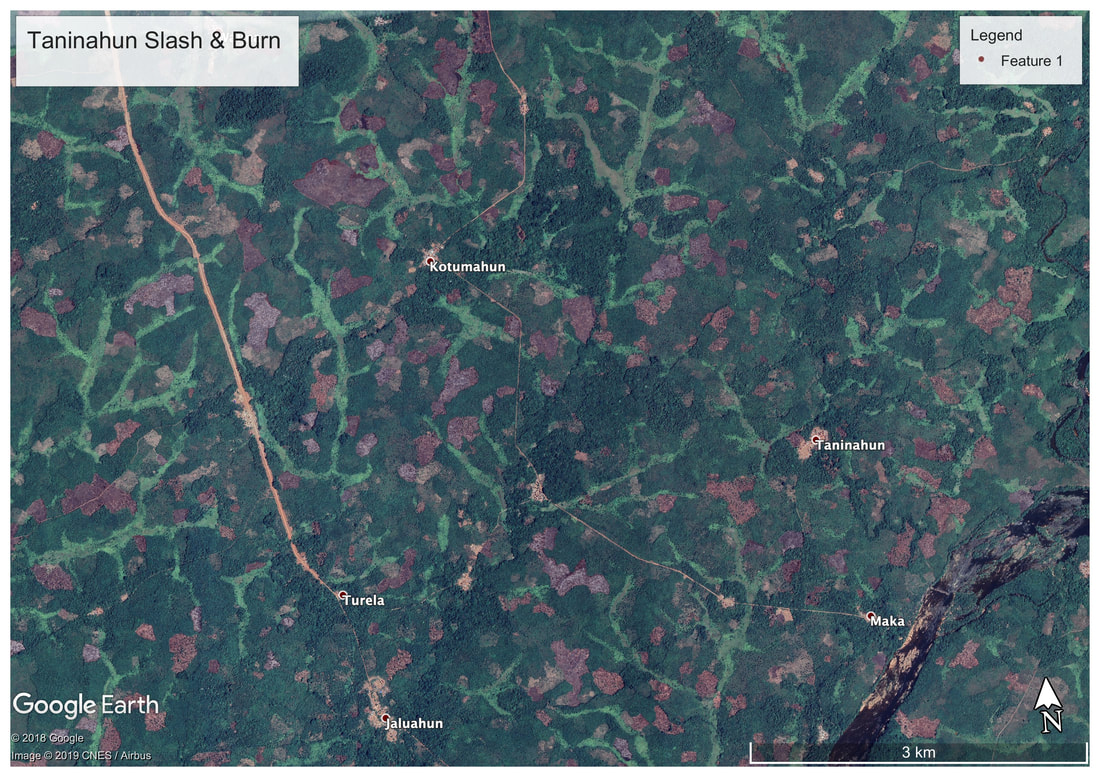Farmers in the Sierra Leone use Slash and Burn as their main farming method (Shifting Cultivation - Swidden)
Slash and Burn Farming is destroying the ecosystem and the environment
it is the only current alternative for farmers to feed their families
"Nearly 1/3rd of CO2 emissions are caused by deforestation" - David Attenborough, Climate Change - The Facts.
Hugh areas in Sierra Leone are burned every year - The brown areas on the map below where burned in March 2018, roughly 25% of available farm land is burned each year.
- Trees, insects, birds, mammals - everything that can’t escape gets burned
- All trees except native palm (food / income) felled and burnt
- Destruction of the forests ability to capture phosphorus (principle contributor to reduction in soil fertility)
- Reducing crop yields due to destruction of the eco system, reduced fallow, inability to capture Phosphorus, Soil erosion. etc.
- 15 to 20% reduction in yields reported to us each year.
WHY DO THEY FARM IN THIS DESTRUCTIVE WAY?
There are currently no resorces, knowledge, assistance or alternatives available to these villagers.
if they want to eat they HAVE to farm in this way
Nearly all of the rural population in Sierra Leone survives by Basic Subsistence farming.
Most families work on their farms each day and harvest what they eat - they rarely have a surplus and often have to eat the seeds required for next seasons planting.
They have almost no food security or resilience to poor or failed crops.
It's very difficult to harvest during the rainy season and most families suffer "the hungry season" 2 months of living on a small handful of rice each day.
Most families have an almost totally carbohydrate diet (Rice, Breadfruit, Cassava) they do not have access to a balanced diet
Nutrition levels are extremely low, malnutrition is very common, especially in children
Protein is rarely available, there are almost no farm animals.
Most families work on their farms each day and harvest what they eat - they rarely have a surplus and often have to eat the seeds required for next seasons planting.
They have almost no food security or resilience to poor or failed crops.
It's very difficult to harvest during the rainy season and most families suffer "the hungry season" 2 months of living on a small handful of rice each day.
Most families have an almost totally carbohydrate diet (Rice, Breadfruit, Cassava) they do not have access to a balanced diet
Nutrition levels are extremely low, malnutrition is very common, especially in children
Protein is rarely available, there are almost no farm animals.
How does Rory's Well program help?
We support an integrated program of farming that give the opportunity for farmers to grow sufficient nutritious food aimed at feeding themselves and produce a surplus for sale.
WITHOUT USING SLASH AND BURN OR DESTROYING THE ENVIRONMENT
Sustainable farming methods for nutrition and livelihood:
1. Inland Valley Swamps
2. Upland Farming
3. Bee Farming
How does Rory’s Well program feed people and combat deforestation by supporting IVS?
|
|
Importance of IVS
RW provides:
|
How does Rory’s Well program feed people and combat deforestation by supporting upland farming?
|
|
Upland farms for nutrition
Highly productive protein source, Beans (Laguums) Groundnuts, Peas Women’s groups super keen Difficult challenge for us to make sustainable - Land fertile for one/two years - move to another plot each year. investment each year in clearing land too big a price and not sustainable (S/Burn dependant) Leads to search for a solution - research lead us to Mike Hands and Inga |


